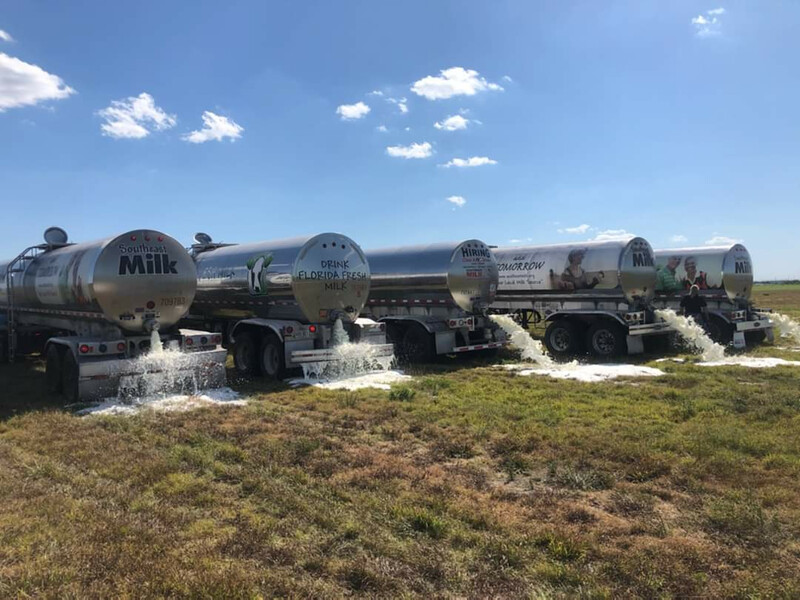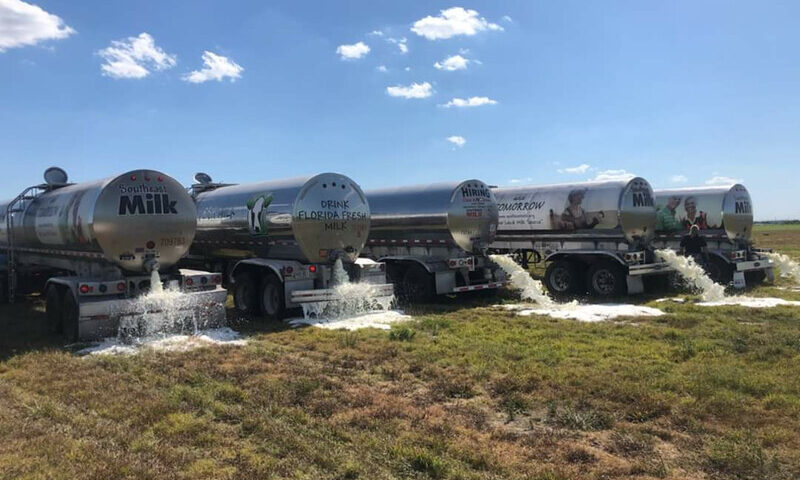From Georgia to Pennsylvania, photos like the one below are flooding social media. Dairy producers are facing a devastating scenario and being forced to dump milk down the drain. For some dairy farmers, this marks a first.

( Ben Butler, Twitter )
“This is the first time in the 32 years I’ve been in business that we’ve had to dump milk in the fields,” says Arnie VanDieden, a dairy producer in Texas.
The Texas producer isn’t alone. Paul Hartman in Reading, Penn. has also been in the business more than 30 years and faced a similar scenario earlier this week.
“Our dairy processor told us on Monday,” says Hartman. “They gave a letter that the driver dropped off that said they were supposed to dump our milk for the next two days; they weren’t going to pick it up. Right away when we heard it, we were shocked. All we hear is the milk is in demand, the stores are having trouble getting it, and then all of a sudden, they’re asking us to dump our milk. So that was kind of confusing.”
The Sudden Loss of Demand
Hartman’s processor told him the reason is a backup in demand. As COVID-19 hit, and industries like restaurants and food services saw an abrupt halt I business, the crisis started to unfold.
“We don’t have an outlet for this milk,” explains Scott Brown, economist with the University of Missouri. “Even if we have plants able to try to process that milk, there’s a little reason to do it at this point due to lack of demand.”
From high-end restaurants to fast food chains, fewer people are eating out and instead, staying at home due to stay-at-home orders. In turn, those consumers are eating fewer pounds of key items like butter and cheese. Therefore, a portion of the nation’s milk supply is without a home.
“The decline in the food service business has not been offset by the increase in the retail side of business,” says Michael Dykes, president and CEO of International Dairy Foods Association (IDFA). “Overnight, we saw a paradigm shift and the business turned upside down.”
The lack of demand from the food service industry is so severe, it’s overshadowing the increase in demand at local grocery stores.
“We don’t have the data yet but will likely post record high and fluid milk consumption in the first quarter of 2020,” says Anna-Lisa Laca, editor of Farm Journal’s MILK. “Unfortunately, that’s not being offset by restaurant demand, and it’s not being offset by our lack of ability to export dairy products in a meaningful way at the moment.”
10% of U.S. Milk Without a Home
IDFA says with fewer restaurants and food services open for normal business, IDFA estimates 10% of the nation’s milk supply is without a home for the foreseeable future.
“That is staggering,” says Dykes. “I think the reason why you’re seeing the reports of dumped milk. This has happened so quickly that the markets can’t adjust.”
Finding a New Home for Lost Demand
Dykes says with the loss of essential demand, IDFA and other dairy groups are lobbying for dairy to be distributed to those who need it most, utilizing current government food programs, especially as unemployment rates grow to levels the U.S. hasn’t seen in nearly 100 years.
“We need to make sure that America’s food banks are replenished,” says Dykes. “When we look at what they’re suggesting, foods banks are buying 10 times as much food as they were on a six-month basis, from $50,000 to $500,000. They’re estimating they need $1.4 billion of food. So, we need to work with the U.S. Department of Agriculture to make sure that food in the food banks is there. Our industry has it, and Americans needed it.”
Dairy Groups Lobby for Programs to Help
While Dykes is in favor of government buying for both domestic and international food aid programs, he doesn’t want to see the government implement a program that artificially boosts prices short-term, acting as a wet blanket on the market later on.
“We don’t want to take actions today that put an overhang in the market,” says Dykes. “We don’t want to suffer the consequences for the next three years, so that we go through another three years like we just went through the last four or five years. Those kinds of programs may sound good on the surface, and we like it when someone’s buying, i.e. the government, but we don’t like it when the government holds on to it for a long time, and then when they start selling, it depresses the market for years.”
Short-Term Pain
While buying for food banks could help dairy find a new home for now, milk futures continue to be in a tailspin. Muted milk prices are putting immense financial pressure on dairy producers.
“We have to take this first 60 to 90 day window, which to me is going to be the toughest and the hardest to survive, and we need to think about the programs that can get money in producers’ pockets or get help and producers pockets as quickly as possible,” says Brown.
The Milk Supply is There
As short-term financial frustrations mount, Hartman and other producers are also frustrated with what they are seeing at some grocery stores. As they are dumping dairy down the drain, some retailers are limiting the amount of milk a shopper can buy during a time when the supply is there, and dairy leaders say logistics are working.
“If they’re being asked grocery store to only take one gallon of milk, I would get after the grocery store and say, ‘why am I allowed to get one gallon when dairy farmers are dumping milk,’” says Hartman. “Let’s take off those restrictions and let people buy as much milk as they can.”
Dykes agrees with urging retailers to remove restrictions on dairy. He says the supply is there and limits on buying aren’t necessary.
“Our members are getting the milk to the grocers,” says Dykes. “The milk is there. We need to remove those signs at any grocery store. There should be no limits on how much milk or any dairy product any consumer can purchase. It is available. Our members are getting it there, and our members are processing the milk.”
Dykes says the supply is there, as processors and food companies are going the extra mile to ensure dairy isn’t missing from refrigerators at any retail location. With COVID-19, he says that is no easy task.
“Our members are going above and beyond to make the make the product available,” says Dykes. “For example, if they weren’t doing three shifts a day, many of them have gone to three shifts, they’ve extended the hours and they are they’re maximizing the output through the plants, all the while preserving food safety. Our members are going above and beyond to make sure that the supply chain is has the product in it for the consumers.”
Mike North of Vault Ag thinks the panic buying has started to soften and agrees the limits on dairy should also disappear.
“I think the first couple days milk was like toilet paper, it went off the shelf and nobody could find anything anywhere,” says North. “Now that we have caught up to that, that is no longer the case and that sign can go away and should go away. Let’s face it; if somebody wants to walk in and buy three or four gallons of milk, let them do it, because on the other side of this, we are dumping milk and the reality is our processors are running around the clock right now doing everything they can to keep up with the demand where there is demand. And it’s for the retail space, and that is in the form of a gallon of milk. Take that sign down because the producer the producers are ready to put that on the shelf.”
Waning Outlooks
As those in the dairy industry lobby for more demand or financial help in other ways, outlooks from farmers are waning.
“At first, it looked like 2020 was going to be a pretty good year, and man did that turn on a dime,” says Hartman.
VanDieden says their family is cutting back on inputs, to try to feed their cows a little cheaper during this tough time. He and other producers are in survival mode, hoping better days for dairying are ahead.
“Since we are shortcutting supply, I believe on the backside of this it does start to open some doors for us to see some better prices,” says North. “Maybe 2020 finishes a lot better than it looks today; cross your fingers”
- Laker Men’s Basketball Handle Kuyper 88-55 - December 23, 2024
- MYWAY Sault Bridge Brawl & NEMWA Regional Results - February 22, 2024
- Crawford County Prosecutor clears State Trooper in the fatal shooting of man earlier this month - February 23, 2023




